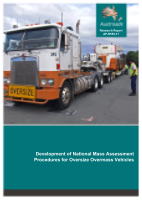Freight

Development of National Mass Assessment Procedures for Oversize Overmass Vehicles
- Publication no: AP-R555-17
- ISBN: 978-1-925671-19-3
- Published: 8 November 2017
- PDF (free) Download
This report describes the conduct of field trials involving repeated weighing of four different Oversize Overmass (OSOM) vehicle combinations using portable scales.
The field test outputs were analysed to determine the level of accuracy to be expected when weighing such vehicles during roadside inspections with portable scales. A number of Mass Measurement Adjustment (MMA) values were developed, similar to those already in use for conventional vehicles (i.e. non-OSOM vehicles) across Australia.
Procedures are described for weighing OSOM vehicles using portable scales on sites complying with the three Site Categories already used for roadside inspections.
The findings are provided as draft guidelines for inspection work.
- Summary
- 1. Introduction
- 1.1. Terminology
- 1.1.1. Mass Versus Weight
- 1.1.2. OSOM
- 1.1.3. Fully-blocked, Partially-blocked and Unblocked Weighing
- 1.1.4. Category 1, Category 2, Category 3
- 2. Literature Review
- 3. Stakeholder Consultation
- 4. Details of Vehicles and Loads
- 4.1. Suspension and Gooseneck Operation
- 4.1.1. Gooseneck Connections to Platform Trailers
- 5. Test Site Layout
- 5.1. Weigh Site Geometry
- 5.2. Weighbridge Geometry
- 6. Vehicle Movements
- 6.1. Weighbridge
- 6.2. Scales
- 7. Test Procedure
- 8. Results
- 8.1. Combination 1
- 8.2. Combination 2
- 8.3. Combination 3
- 8.4. Combination 4
- 9. Discussion
- 9.1. Sources of Error
- 9.1.1. Simulated Split-weigh on Weighbridge
- 9.1.2. Effects of Diagonally Packed-up Weighing
- 9.1.3. Grade of Weighbridge Approach and Departure
- 9.1.4. Weighbridge Sensitivity to Axle Location
- 9.1.5. Category 2 vs Category 3 Trailer and Combination Results
- 10. Mass Measurement Adjustment
- 10.1. Background
- 10.2. Mass Measurement Adjustment Calculation Method
- 10.3. Mass Measurement Adjustment Tables
- 11. Weighing Guidelines
- 11.1. Purpose
- 11.2. Scope
- 11.3. Definitions
- 11.4. Mass Limits
- 11.5. Equipment Standards
- 11.6. Weigh Site Categorisation
- 11.7. Preparation for Weighing
- 11.8. Weighing on a Weighbridge
- 11.9. Measuring Mass on Portable Scales
- 11.9.1. Fully-blocked Method
- 11.9.2. Partially-blocked Method
- 11.10. Mass Measurement Adjustment Tables
- 11.11. Portable Scale Weighing Examples
- 11.11.1. Fully-blocked Method
- 11.11.2. Partially-blocked Method
- 11.12. Other Combinations
- References
- Appendix A Vehicle Moves Used in Field Trials
- Appendix B Tabulated Field Trial Results
- Appendix C Technical Specifications for Weighing Categories
Related publications
Latest Freight News
